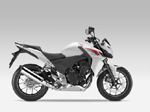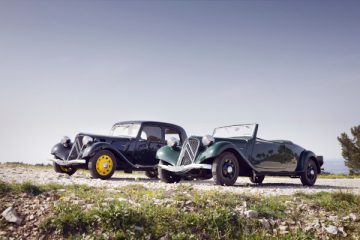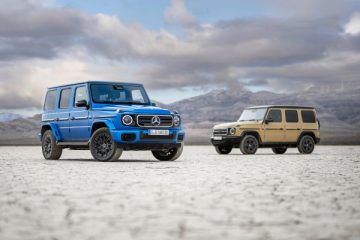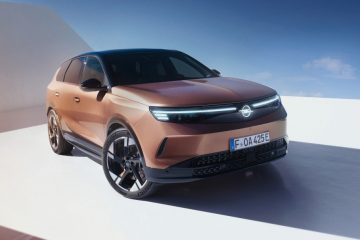 New model: A naked middleweight twin, one of a brand new trio of motorcycles. Fun, agile, light, economic to run, with strong design cues from the CB1000R, and a very affordable price point. 35kW engine – perfect for A2 license holders.
New model: A naked middleweight twin, one of a brand new trio of motorcycles. Fun, agile, light, economic to run, with strong design cues from the CB1000R, and a very affordable price point. 35kW engine – perfect for A2 license holders.
Contents:
1 Introduction
2 Model overview
3 Key features
4 Accessories
5 Technical specifications
1. Introduction
Ideal for any rider stepping up from a smaller machine or holding an A2 licence, the naked CB500F, part of a new
While the CB500F, CBR500R and CB500X are focused in different directions they are all easy to manage, and deliver all-round practicality matched to excellent efficiency. And blessed with lightweight agility and an engaging power delivery they are also enjoyable to ride in every scenario.
A perfect platform from which to experience the fun and freedom that motorcycling brings, the CB500F makes a great first “full-size” bike for any rider – and with its high build quality, affordable price point and low running costs will also make a great long-term partner and practical choice for riders of all experience levels.
 2. Model Overview
2. Model Overview
The naked CB500F takes styling cues from the stripped-down four-cylinder CB1000R, and its slim form offers great urban ability as well as enjoyable, out-of-town performance. It is also comfortable for a large range of rider sizes (especially smaller riders who can sometimes be intimidated by physically bulky motorcycles) thanks to clever ergonomics. Its DOHC twin-cylinder fuel-injected engine produces 35kW (making it ideal for new 2013 A2 licence holders moving up a class) and returns an impressive 27km/l (75mpg) (WMTC figure).
The steel diamond frame and high quality suspension – 41mm telescopic front forks matched to Pro-Link rear monoshock – provide confident, precise handling as do 17-inch cast aluminium wheels and wide 120 front, 160 rear radial tyres. Wave-pattern disc brakes provide powerful, yet easy to control stopping power, and ABS is available as an option
3. Key Features
3.1 Chassis
The CB500F’s 35mm diameter steel diamond-tube mainframe is light and strong, and has a tuned degree of yield that gives plenty of feedback to the rider as road surfaces change. The shape and position of the engine mounts, and the frame’s rigidity balance, have also been carefully optimised to reduce vibration.
 Wheelbase is 1410mm and rake and trail are set at 25.5°/102.6mm giving nimble, yet reassuring steering. Mass centralisation, with the engine in very close proximity to the swingarm pivot point, delivers turning agility, and optimum front/rear weight distribution ensures stability. Kerb weight is 190kg; the ABS option adds an extra 2kg. Seat height is low at 790mm, making the CB500F very easy to manage and its sporty riding position will comfortably accommodate riders of varying heights thanks to a high handlebar position.
Wheelbase is 1410mm and rake and trail are set at 25.5°/102.6mm giving nimble, yet reassuring steering. Mass centralisation, with the engine in very close proximity to the swingarm pivot point, delivers turning agility, and optimum front/rear weight distribution ensures stability. Kerb weight is 190kg; the ABS option adds an extra 2kg. Seat height is low at 790mm, making the CB500F very easy to manage and its sporty riding position will comfortably accommodate riders of varying heights thanks to a high handlebar position.
Overall dimensions are 2075mm x 780mm x 1060mm, with 155mm ground clearance. The fuel tank holds 15.7-litres, including reserve, and combined with the engine’s excellent fuel economy gives potential range of over 420 km (over 260 miles).
The 41mm telescopic front fork, with 120mm stroke, delivers a compliant yet controlled ride and gives a great connection to the front tyre. Pro-Link monoshock rear suspension features optimised leverage ratios and 9-stage preload adjustment for the rear shock. It works with a rigid wingarm, constructed from 70mm x 30mm box-section steel. Final drive is via 520 sealed chain.
Lightweight, 17-inch cast aluminium wheels employ hollow cross-section Y-shaped spokes. Front wheel width is 3.5-inch with a 120/70-ZR17 tyre, rear wheel width is 4.5-inch with a 160/60-ZR17 tyre. A single front 320mm wavy disc and two-piston brake caliper is matched to a 240mm rear disc and single-piston caliper.
The comprehensive dash features a digital speedometer, digital bar graph tachometer, odometer, dual trip meters, clock, plus digital fuel level gauge and fuel consumption. HISS (Honda Intelligent Security System) is built in to the ignition, and the headlight features a single 60/55W H4 Halogen bulb and multi-reflectors. There is space under the seat to store a U-lock.
The CB500F will be available in three colour options:
-
Pearl Himalayas White
-
Graphite Black
-
Candy Ruby Red
3.2 Engine
The CB500F’s engine is a next generation power unit, looking to the future in both performance and environmental terms. The DOHC, 8-valve liquid-cooled parallel twin layout was chosen because of its light weight, all-round ability and flexible usability.
Bore and stroke is set at 67mm x 66.8mm; the crankshaft pins are phased at 180° and a primary couple-balancer sits behind the cylinders, close to the bike’s centre of gravity. The primary and balancer gears use scissor gears, reducing noise. The crank counterweight is specifically shaped for couple-balance and its light weight allows the engine to spin freely, with reduced inertia. PGM-FI fuel injection provides superb throttle response and peak power of 35kW arrives at 8,500rpm, with 43.1Nm torque delivered at 7,000rpm.
The ‘triangle’ proportion of crankshaft, main shaft and countershaft is very similar to that of Honda’s four-cylinder RR engines, making for a very compact unit. The six-speed gearbox also mirrors that of its RR cousins, allowing for a short engine, and uses the same gear change arm structure and link mechanism. A deep sump reduces oil movement under hard cornering and braking; oil capacity is 3.2-litres. Flow analysis of the cooling system through CAE (Computer Aided Engineering) maximised efficiency and allows the use of a physically smaller, and lighter, water pump.
The DOHC cylinder head uses compact roller rocker arms; shim-type valve adjustment allows them to be light, which means lower valve-spring load and reduced friction. A silent (SV Chain) cam chain has the surface of its pins treated with Vanadium, reducing friction with increased protection against dust. Inlet valve diameter is 26.0mm, exhaust valve diameter 21.5 mm. CFD (Computational Fluid Dynamic) was used to maximise gas flow efficiency – the route from airbox to exhaust pipe was made as straight as possible, and a plate in the airbox separates the air flow to each cylinder.
Bore size of 67mm is identical to that of the CBR600RR. CAE was used to ensure the pistons have the optimum balance between weight, strength and rigidity. The shape of the piston itself was based upon those used in the CBR1000RR. Friction is reduced by the addition of striations on the piston skirt (a finish that increases surface area, introducing gaps in which oil can flow for better lubrication). As with the CBR600RR and CBR1000RR, an AB1 salt bath process, used after isonite nitriding, forms a protective oxidisation membrane.
The crankcase uses centrifugally-cast thin-walled sleeves, and the same bore interval as the CBR600RR helps them be as compact and light as possible. Careful attention has been paid to their internal design to reduce the pumping losses that can occur with a 180° phased firing order. Using the same internal relief structure as that of the CBR1000RR, the oil pump features improved aeration performance, with reduced friction and allows use of a simple oil pan.
The engine itself acts as a stressed member, reinforcing the frame’s rigidity with four frame hangers on the cylinder head. The Matt Axis Grey Metallic finish on the crankcase and cylinders finish adds depth, complementing its taut overall styling.
A secondary air injection (AI) system is built into the cylinder heads, while an oxygen sensor and catalyser inside the 2-1 exhaust ensures the CB500F’s emissions are extremely low.
4. Accessories
The following genuine accessories will be available for the CB500F:
-
Panniers (with moving system)
-
Rear carrier
-
Top box
-
High windscreen
-
Seat cowl
-
Under cowl
-
Meter visor
-
Chain case
-
U-lock
-
Tank pad
-
Heated grips (12A)
-
Cover
5. Technical Specifications
|
ENGINE |
||
|
Type |
Liquid-Cooled, parallel twin |
|
|
Displacement |
471 cc |
|
|
No of Valves per Cylinder |
4 |
|
|
Bore ´ Stroke |
67mm x 66.8mm |
|
|
Compression Ratio |
10.7 : 1 |
|
|
Max. Power Output |
35kW @ 8500 rpm |
|
|
Max. Torque |
43 Nm @ 7000 rpm |
|
|
Oil Capacity |
3.2L |
|
|
FUEL SYSTEM |
||
|
Carburation |
PGM FI |
|
|
Fuel Tank Capacity |
15.7L (inc reserve) |
|
|
Fuel Consumption |
27Km/L (WMTC) |
|
|
ELECTRICAL SYSTEM |
||
|
Starter |
Motor |
|
|
Battery Capacity |
12V 8.6AH |
|
|
ACG Output |
23.4A/2000rpm |
|
|
DRIVETRAIN |
||
|
Clutch Type |
Wet multiplate |
|
|
Transmission Type |
6 speed |
|
|
Final Drive |
Chain |
|
|
FRAME |
||
|
Type |
Steel, Diamond |
|
|
CHASSIS |
||
|
Dimensions (L´W´H) |
2075mm x 780mm x 1060mm |
|
|
Wheelbase |
1410mm |
|
|
Caster Angle |
25.5 degrees |
|
|
Trail |
102.6 |
|
|
Seat Height |
790mm |
|
|
Ground Clearance |
155mm |
|
|
Kerb Weight |
190Kg / 192Kg ABS model |
|
|
Dry Weight |
173.4Kg /175.4Kg ABS model |
|
|
SUSPENSION |
||
|
Type |
Front |
Conventional Telescopic Front Forks, 41mm |
|
|
Rear |
Prolink mono with 9-stage Preload adjuster, steel square pipe swingarm |
|
WHEELS |
||
|
Type |
Front |
Multi-Spoke Aluminium Cast |
|
|
Rear |
Multi-Spoke Aluminium Cast |
|
Rim Size |
Front |
17 x MT3.5 |
|
|
Rear |
17 x MT4.5 |
|
Tyres |
Front |
120/70ZR – 17M/C |
|
|
Rear |
160/60ZR – 17M/C |
|
BRAKES |
||
|
ABS System Type |
N/A / 2-Channel |
|
|
Type |
Front |
Single Wavy Disk, 320mm, 2 POT caliper |
|
|
Rear |
Single Wavy Disk, 240mm, 1 POT caliper |
|
INSTRUMENTS & ELECTRICS |
||
|
Instruments |
Digital Speedometer, Digital Bar Graph Tachometer, Dual Trip Meters, Digital Fuel Level Gauge & Fuel Consumption Gauge, Digital Clock |
|
|
Security System |
HISS (Honda Intelligent Security System) |
|
|
Headlight |
60/55W x 1 light |
|
All specifications are provisional and subject to change without notice.
# Please note that the figures provided are results obtained by Honda under standardised testing conditions prescribed by WMTC. Tests are conducted on a rolling road using a standard version of the vehicle with only one rider and no ![]() additional optional equipment. Actual fuel consumption may vary depending on how you ride, how you maintain your vehicle, weather, road conditions, tire pressure, installation of accessories, cargo, rider and passenger weight, and other factors.
additional optional equipment. Actual fuel consumption may vary depending on how you ride, how you maintain your vehicle, weather, road conditions, tire pressure, installation of accessories, cargo, rider and passenger weight, and other factors.




